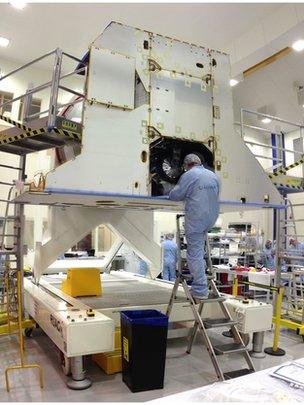Europe's Mercury mission takes shape
- Published
- comments

The British-built structure of the MPO is about to be shipped to Italy
It's hot, hot, hot! Any spacecraft that plans to visit the innermost planet, Mercury, gets double the trouble.
On one side, it's baked by the Sun, receiving some 14,000 watts per square metre, about 10 times what a spacecraft in orbit around Earth would receive.
But the spacecraft is also then baked on the other side because the planet itself is a "hot potato", where surface temperatures can reach 470C.
It's a hellish nightmare and designing a probe that could handle this extreme environment very nearly flummoxed Europe's best engineers.
The BepiColombo, external mission's difficulty in arriving at technical solutions to meet the thermal challenge greatly increased costs and brought the venture perilously close to cancellation.
Bepi is now progressing well through its construction phase - albeit way behind on the original schedule - and should be ready for launch in 2015.
The European Space Agency (Esa) mission is a joint venture with Jaxa, the Japanese national space agency.
Europe is providing a Mercury Planetary Orbiter (MPO). This will carry 11 scientific instruments. It will fly in a polar orbit around the planet, imaging the surface, generating height profiles, and collecting data on surface composition and the wispy "atmosphere".
Japan's contribution is the Mercury Magnetospheric Orbiter (MMO). This will have five instruments and will investigate the planet's magnetic field. Mercury, you will recall, is the only terrestrial planet (apart from Earth) to have global magnetic field.
The UK has a prominent role on the mission. Its engineers have been responsible for the construction of the MPO spacecraft's structure and propulsion system. British brains have also done the complex mission analysis to work out how to fly into the deep gravity well of the inner Solar System. BepiColombo will have to swing by Earth once, Venus twice, and Mercury four times to get itself into the right position to map the planet.
The image at the top of this page is the main structure of the MPO at the Astrium factory in Stevenage. It's being shipped this week to Thales Alenia Space in Turin for further fitting, including the installation of the European mission's 11 instruments.
Dr Dave Rothery: "Messenger has opened our eyes"
The MPO has an unusual shape for a planetary probe but, again, that's a consequence of where it needs to operate. The long edge along the bottom will be the location for a big radiator that will be kept pointed away from the Sun at all times.
"We have lots and lots of heat pipes on board," explained Astrium spacecraft systems engineer Jess Marshall.
"These have a small amount of ammonia in them. This evaporates, whizzes up the tubes and then condenses at the radiator. Everything about this spacecraft is about staying cool.
"Bepi is unusual in that it will look white. Our spacecraft normally have a gold-coloured, multi-layered insulation. Bepi's insulation will have to be much more robust - it will be a lot thicker, a lot heavier. The white outer covering will reflect a lot of heat away, but we must be very careful also that there are no holes anywhere - no gaps - or that heat will creep in."
Many people's reaction to Mercury is that it is a bit of a dullard. Unlike Mars with its many Earth-like vistas, the inner world appears very one dimensional. The US Messenger probe now in orbit has gone a long way I think to countering that viewpoint.
It has thrown up many surprises and challenged our assumptions about what the closest planet to the Sun should be like.
Messenger has revealed Mercury's rich volcanic history. It has confirmed the existence of great lava plains, but also uncovered evidence for explosive volcanism.
The probe has identified lots of sulphur (2-4%) in the surface. That wasn't expected. Indeed, there are many more volatile substances in Mercury's surface than would be expected. They simply shouldn't be there in a planet that orbits so close to the Sun, or one that - according to the popular idea - was involved in a mighty collision that ripped away its upper-most layers. And then there are these dramatic hollows that have been discovered.
This strange pock-marked terrain is yet further evidence of the release of volatile material evaporating away into space.
"We're not quite sure what that material is yet," said Dr Dave Rothery. The Open University researcher is chief scientist on BepiColombo's Mercury Imaging X-ray Spectrometer (MIXS).
"[With Bepi] we'll have sufficiently high spatial resolution with the X-ray telescope to see what the elemental distribution is within these quite small hollowed areas. "Messenger can't do that - it has a much cruder, coarser resolution. So, we'll learn a lot more when we get a more sophisticated spacecraft there, but we already know it's an absolutely fascinating planet which is not doing what it ought to do.
"That's the joy of planetary exploration - you work out what you should expect to see to test your hypotheses and then you go there and find, 'crikey, this wasn't what we expected at all'.
"We've got to have a big re-think and until we understand how Mercury formed we won't understand how our own planet formed."

Messenger has found hollowed out surface features that indicate the loss of volatile material